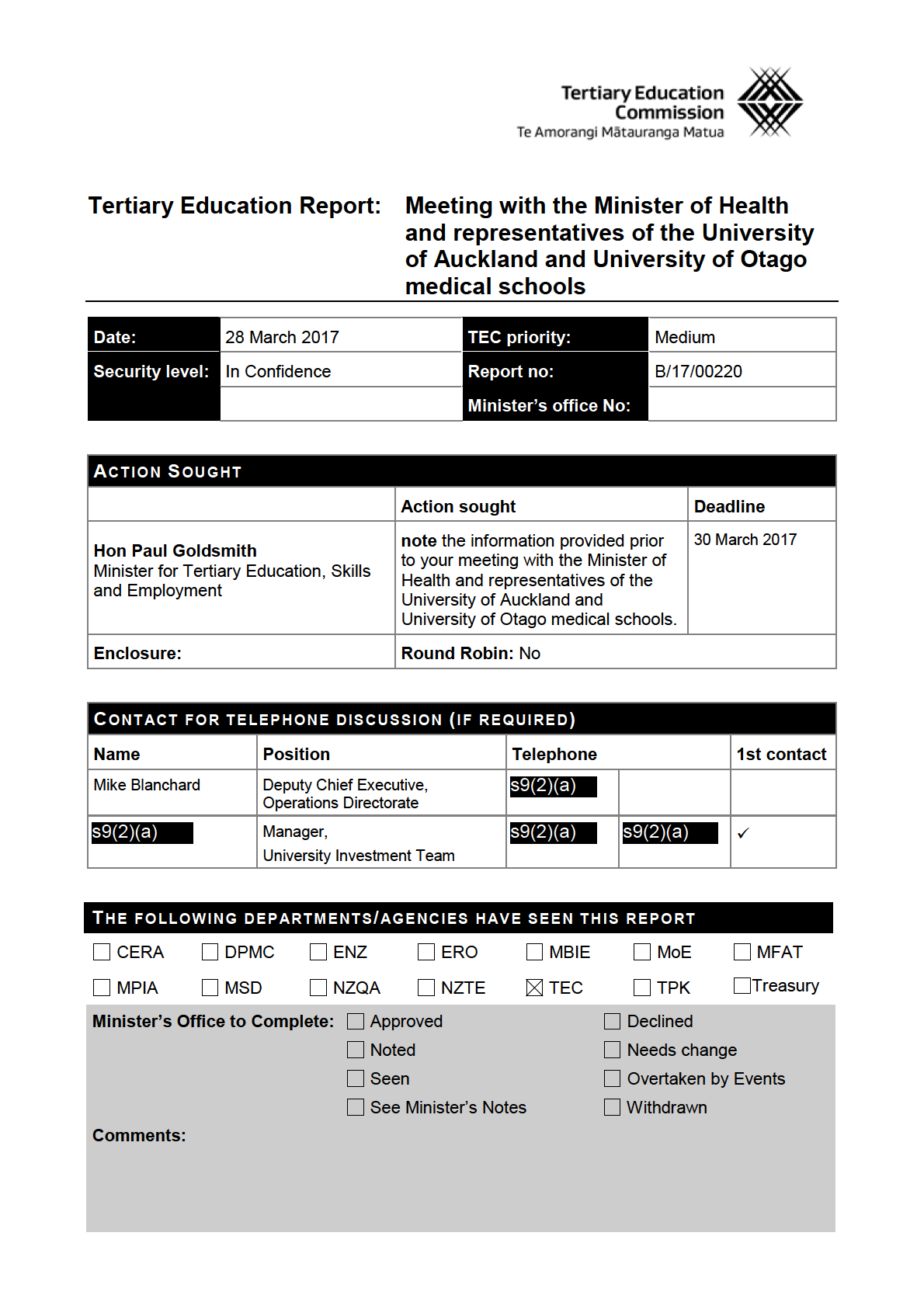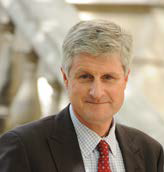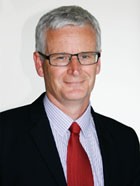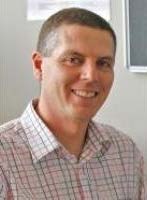

T E R T I A R Y E D U C A T I O N R E P O R T : M E E T I N G W IT H T H E M I N I S T E R O F H E A L T H A N D R E P R E S E N T A T I V E S O F T H E
U N I V E R S IT Y O F A U C K L A N D A N D U N IV E R S I T Y O F O T A G O M E D I C A L S C H O O L S
Recommendations
Hon Paul Goldsmith, Minister for Tertiary Education, Skills and Employment
It is recommended that you:
1.
note the information provided prior to your meeting with the Minister of Health and
representatives of the University of Auckland and University of Otago medical schools.
Mike Blanchard
Deputy Chief Executive, Operations
Tertiary Education Commission
28 March 2017
Hon Paul Goldsmith
Minister for Tertiary Education, Skills and Employment
__ __ / __ __ / __ __
R E P O R T N U M B E R : B / 1 7 / 0 0 2 2 0
| 2
T E R T I A R Y E D U C A T I O N R E P O R T : M E E T I N G W IT H T H E M I N I S T E R O F H E A L T H A N D R E P R E S E N T A T I V E S O F T H E
U N I V E R S IT Y O F A U C K L A N D A N D U N IV E R S I T Y O F O T A G O M E D I C A L S C H O O L S
Purpose
1. We understand that you will be meeting with representatives of the University of Auckland
(Auckland) and University of Otago (Otago) Medical Schools on 6 April 2017 to discuss the
Auckland/Otago joint Rural Health Education proposal.
2. You will be meeting with Professors John Fraser and Warwick Bagg from the University of
Auckland and Professor Peter Crampton from the University of Otago. Biographies for these
are provided in Appendix 1. It is understood that the Minister of Health, Hon Jonathan
Coleman, will also attend the meeting.
3. It is possible that the discussions will also refer to the University of Waikato/Waikato DHB (the
Waikato) proposal to establish a third medical school. We have previously provided
information to you summarising the Waikato proposal and our advice to Ministers
(AM/17/00011 refers).
4. Our advice was that the proposal has merit and warrants further consideration, but that
Waikato’s business case requires revision to comply with Treasury's Better Business Case
guidelines. A letter was drafted to be sent by yourself and Minister Coleman requesting a
revised business case, which meets the requirements of an Indicative Business Case (IBC).
The letter also encourages Waikato and the DHB to engage with relevant stakeholders in
developing its proposal.
5. We are also aware that the Prime Minister has asked the Department of Prime Minister and
Cabinet to compile some advice on the proposal for his consideration.
The Auckland/Otago joint Rural Health Education concept
A bespoke rural health faculty would be jointly established between communities and the
universities
6. Auckland and Otago have submitted a joint concept document (the Auckland/Otago concept)
outlining their proposal to create a new national School of Rural Health (SRH), in association
with the Royal New Zealand College of General Practitioners (RNZCGP) and the New Zealand
Rural General Practice Network (NZRGPN).
7. The proposal would involve building a dispersed inter-professional faculty based at up to 20
sites located in rural communities across New Zealand. These sites would be co-developed
and co-governed by iwi and local communities, and be clinician-led.
Students from a variety of health-related programmes would have enhanced exposure to
rural communities
8. The SRH would allow students to access a rural component as part of their studies and
improve the integration of undergraduate teaching, early post-graduate medical and vocational
practice, and rural hospital medicine. In addition, students would be able to undertake rural
immersion clerkships and there would be opportunities for inter-professional education for all
health professionals as well as research development in the rural context.
9. Auckland and Otago consider that their Rural Immersion Programme and Northland
Pūkawakawa initiatives show that focused investment can achieve positive results for rural and
regional communities. The SRH would extend current coverage and deliver significantly
improved results for rural communities.
R E P O R T N U M B E R : B / 1 7 / 0 0 2 2 0
| 3
T E R T I A R Y E D U C A T I O N R E P O R T : M E E T I N G W IT H T H E M I N I S T E R O F H E A L T H A N D R E P R E S E N T A T I V E S O F T H E
U N I V E R S IT Y O F A U C K L A N D A N D U N IV E R S I T Y O F O T A G O M E D I C A L S C H O O L S
The amount of funding required from government is unknown
10. Auckland and Otago indicate that the SRH could be established at marginal extra cost given
the existing administrative, academic and curriculum infrastructure of the two universities, and
the support of the RNZCGP and NZRGPN.
11. Informal indicative information from Auckland and Otago indicates the SRH will require
operational expenditure of roughly $5 million in year one, rising to $25 million when fully
established (years 5-8). The parties have not given us any information on the nature of this
funding e.g. Student Achievement Component Level 3 and above (SAC 3+), or funding to
support clinical placements through Health Workforce NZ.
12. Capital expenditure is informally estimated at roughly $32 million over eight years. It is
uncertain from the information provided whether Auckland and Otago would seek government
funding to cover all, or part of the capital costs, or whether funding will come from existing cash
reserves, borrowing consents or other sources. Both Universities are in a good financial
position and can probably support this from their own balance sheets.
Comparison to the Waikato proposal
The Waikato proposal would still train graduate doctors over a shorter period of time
13. We have previously provided you with a summary of the Waikato proposal and how it differs
from current medical provision (AM/17/00011 refers).
14. Waikato’s proposed medical programme is a four-year graduate entry only programme.
Waikato has indicated that the new programme will focus on attracting students who already
have a qualification (in any subject) and have chosen to pursue a medical career later, rather
than school-leavers.
15. The SRH proposes no changes to the duration of current medical qualifications. Auckland and
Otago both primarily offer six-year medical programmes that focus on enrolling school-leavers.
However, both universities operate a graduate entry scheme that allows those who already
have an undergraduate degree to progress straight into the second year. About 30% of
students commencing the second year of the medical training programme enter as graduates
from another degree programme.
Both proposals acknowledge that more needs to be done to ensure rural communities have
adequate healthcare
16. Prospective students at Waikato would be selected based on academic criteria and how likely
the student is to pursue a rural career path. The school would also leverage Waikato’s high
level of Māori participation and the regional demographic to attract more Māori students into
medical training.
17. Auckland and Otago operate three preferential admission schemes – Māori, Pacific and rural.
Both Auckland and Otago are now preferentially enrolling Māori at demographic equity with a
completion rate of over 90% and both universities report similar success for Pasifika.
18. The current Rural and Regional Admissions Schemes (RRAS) aim to attract students from a
rural background. Both Auckland and Otago have established training options in rural and
regional settings and report a significant number of students undertaking these options.
Around 50% of students admitted under the RRAS move into rural practice but there is little
information on how long they remain there.
R E P O R T N U M B E R : B / 1 7 / 0 0 2 2 0
| 4
T E R T I A R Y E D U C A T I O N R E P O R T : M E E T I N G W IT H T H E M I N I S T E R O F H E A L T H A N D R E P R E S E N T A T I V E S O F T H E
U N I V E R S IT Y O F A U C K L A N D A N D U N IV E R S I T Y O F O T A G O M E D I C A L S C H O O L S
19. Auckland and Otago consider they are training sufficient medical students to meet future health
workforce needs, but agree that there is a need to deliver more graduates who aspire to work
in rural communities to meet the health needs of rural communities and address inequity.
The Waikato proposal and Auckland/Otago concept propose a dispersed rurally-based
model
20. The Waikato proposal also includes a dispersed model for clinical education and training
centres, enabling students to undertake clinical placements in rural communities. The
Auckland/Otago concept takes this further as it aims to integrate medical, allied health and
nursing workforces, rather than focussing on medical programmes.
The Waikato proposal seeks greater investment
21. The Waikato proposal indicates that capital funding of between $58 million and $70 million is
required to establish the school and that operating expenditure will be between $142 million
and $240 million over a ten-year period. There will be some offset associated with shortening
training for graduate entry places.
22. Preliminary rough costs for the Auckland/Otago concept indicates capital funding of
approximately $32 million over eight years with operational expenditure of roughly $5 million
rising to $25 million once fully established.
The Waikato proposal focusses on recruiting students who are more likely to choose rural
practice
23. The proposed Waikato programme is a four-year graduate entry programme with students able
to enter from any prior degree programme providing they meet academic and dispositional
criteria.
24. It is noted that the Waikato proposal notes student selection criteria will be used to select
students who from the outset are more likely to select a career in rural practice. These criteria
based on those used in international medical schools with successful rural training outcomes
e.g. the Northern Ontario School of Medicine. The Auckland/Otago concept does not address
this.
The Auckland/Otago concept is multidisciplinary
25. The Auckland/Otago concept makes provision for inter-professional education by bringing other
students and practitioners into the SRH. This has the potential to help address rural shortages
in other professions eg nursing, nurse-practitioner, physiotherapy, pharmacy, and dietetics as
well as medicine. The Waikato proposal does not include bringing other professions into its
medical school.
Preliminary reviews on the Auckland/Otago concept
Additional work is required to turn the concept document into a full business case
26. The concept document provided will need extensive work to develop it into a business case
that Ministers can use to make a decision. The current concept document lacks detail and
significant work will be required to develop it into a business case that meets the Treasury’s
Better Business Case guidelines. This is particularly disappointing given Auckland and Otago
have indicated they have worked on the concept for a number of years.
27. It is also noted that whilst some preliminary rough costs have been provided, there is no
information where capital funding will come from. Providing full financial information should be
prioritised as no decision can be made unless the quantum of funding involved is known.
R E P O R T N U M B E R : B / 1 7 / 0 0 2 2 0
| 5
T E R T I A R Y E D U C A T I O N R E P O R T : M E E T I N G W IT H T H E M I N I S T E R O F H E A L T H A N D R E P R E S E N T A T I V E S O F T H E
U N I V E R S IT Y O F A U C K L A N D A N D U N IV E R S I T Y O F O T A G O M E D I C A L S C H O O L S
There is no indication of how the scheme will aid rural medical staff retention
28. The Auckland/Otago concept recognises that there are issues with the rural health workforce
and appears to acknowledge that medical training needs to change if it is to meet the future
needs of rural communities. The concept aims to integrate medial and allied-health
professions and acknowledges rural communities as a great source of research and education.
29. However, the concept lacks information on how it will address sustainability issues with the
rural workforce nor does it address how it will ensure students participating in SRH
programmes will transition into rural practice and remain in practice there.
Despite this, there is good stakeholder buy-in and the concept addresses ‘status’ issues
within general practice
30. In addition, the concept notes that generalist scopes of practice that are so important in rural
health care lack the emphasis and status they need within health professional education and
academia, making them less attractive career paths.
31. It is noted that the concept seems to have robust support from stakeholders, which is important
in developing a successful intervention that requires buy-in from the community, the medical
and allied-health workforce and government.
32. Questions you may wish to put to Professors Fraser, Bagg and Crampton are provided in
Appendix 2.
Background information about current medical provision
33. Medical provision is considered high-cost and the amount of delivery is therefore capped on
the first-year equivalent full-time students (EFTS) intake, currently capped at 539 EFTS. The
level of the cap between 2008 and 2017 is illustrated in Table 1 below. There is a commitment
to raise the cap to 565 EFTS, but this has been paused due to concerns about the capacity to
provide clinical placements for final year students and changes in the Australian medical
system resulting in more New Zealand doctors repatriating.
Table 1 – Medical EFTS cap (first year intake)
2008
2009
2010
2011
2012
2013
2014
2015
2016
2017
First year EFTS cap
155
155
191
191
219
219
233
257
257
257
(Auckland)
First year EFTS cap (Otago)
210
210
234
254
266
266
272
282
282
282
Total Cap
365
365
425
445
485
485
505
539
539
539
34. Auckland and Otago work together to agree the distribution of the cap. Auckland and Otago
utilise their full allocation of EFTS and demand for places at both medical schools exceeds
availability.
35. In 2015, Auckland delivered over $44.5 million SAC 3+ funded provision to just over 1,100
EFTS at level 7 (and above) in years 2-6 of its Bachelor of Medicine/Bachelor of Surgery
qualification. In 2015, Otago delivered over $52 million to just over 1,300 EFTS at level 7 (and
above) in years 2-6 of its Bachelor of Medicine/Bachelor of Surgery qualification. The current
SAC 3+ funding rate for undergraduate medicine in years 2-6 of study is $42,622 per EFTS.
R E P O R T N U M B E R : B / 1 7 / 0 0 2 2 0
| 6



T E R T I A R Y E D U C A T I O N R E P O R T : M E E T I N G W IT H T H E M I N I S T E R O F H E A L T H A N D R E P R E S E N T A T I V E S O F T H E
U N I V E R S IT Y O F A U C K L A N D A N D U N IV E R S I T Y O F O T A G O M E D I C A L S C H O O L S
Appendix 1 – Biographies
Professor Peter Crampton – Pro-Vice-Chancellor, Health Sciences (and Dean, Otago
Medical School)
Peter Crampton graduated from the University of Otago Medical School
and then worked as a general practitioner before training in Public Health
Medicine. His PhD thesis was on aspects of the delivery of primary health
care.
In 2002–2003, Peter went to John Hopkins University in the United States
on a Harkness Fellowship in Health Policy.
Professor John Fraser – Dean, University of Auckland Medical School
John Fraser gained a BSc with Honours at Victoria University of
Wellington followed by a PhD at the University of Auckland, both in
biochemistry.
His ground-breaking research in molecular aspects of the immune
response began at Harvard University, where his work led to the
investigation of the structure, function and role in disease of super-
antigenic toxins. Professor Fraser’s research resulted in the now widely
accepted model of how super-antigens work.
Professor Fraser is a former deputy director of the Maurice Wilkins Centre
for Molecular Biodiscovery and is a Fellow of the Royal Society of New
Zealand.
Professor Warwick Bagg – Head of the Medical Programme, University of Auckland
Professor Bagg gained his medical qualifications Johannesburg, and
subsequently moved to New Zealand where he completed his post-graduate
medical training.
He is Head of the Medical Programme at the University of Auckland and also
works as an endocrinologist and diabetologist at Green Lane Hospital and in
private practice at the Mercy Specialist Centre. He is also a reporting doctor
for Auckland Bone Density.
R E P O R T N U M B E R : B / 1 7 / 0 0 2 2 0
| 7
T E R T I A R Y E D U C A T I O N R E P O R T : M E E T I N G W IT H T H E M I N I S T E R O F H E A L T H A N D R E P R E S E N T A T I V E S O F T H E
U N I V E R S IT Y O F A U C K L A N D A N D U N IV E R S I T Y O F O T A G O M E D I C A L S C H O O L S
Appendix 2 – Questions you may wish to put to Professors Fraser, Bagg
and Crampton regarding the Auckland/Otago concept
Funding requirements
• Will a Business Case be provided that meets Treasury’s Better Business Case
requirements? Please provide more information around when a full business case will be
provided.
• When will full financial information regarding the proposal be made available? Do the
Universities of Auckland and Otago propose to cover some of the costs from their own cash
reserves?
Workforce sustainability
• How will the universities encourage students to seek employment (and remain employed) in
rural practice
• Does the university have any plans to address the long-term sustainability of the rural
workforce i.e. encouraging new practitioners to maintain positions in rural practice?
Scope
• What geographical coverage do you envisage the SRH having? Where are you planning to
locate the rural sites that the SRH will occupy?
Involvement with other tertiary education providers
• Have you considered working on with the University of Waikato and Waikato DHB to deliver
a joint initiative? Would you work with other providers (e.g. institutes of technology and
polytechnics) that provide training for allied-health professionals eg midwifery, nursing and
paramedicine?
R E P O R T N U M B E R : B / 1 7 / 0 0 2 2 0
| 8




